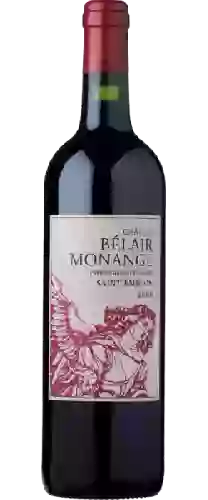
Château Belair-MonangeChâteau Belair Saint-Émilion (1er Grand Cru Classé)
This wine is a blend of 3 varietals which are the Cabernet franc, the Cabernet-Sauvignon and the Merlot.
In the mouth this red wine is a powerful with a nice balance between acidity and tannins.
This wine generally goes well with poultry, beef or game (deer, venison).
The Château Belair Saint-Émilion (1er Grand Cru Classé) of the Château Belair-Monange is in the top 10 of wines of Saint-Émilion Grand Cru.
Taste structure of the Château Belair Saint-Émilion (1er Grand Cru Classé) from the Château Belair-Monange
Light | Bold | |
Smooth | Tannic | |
Dry | Sweet | |
Soft | Acidic |
In the mouth the Château Belair Saint-Émilion (1er Grand Cru Classé) of Château Belair-Monange in the region of Bordeaux is a powerful with a nice balance between acidity and tannins.
Wine flavors and olphactive analysis
On the nose the Château Belair Saint-Émilion (1er Grand Cru Classé) of Château Belair-Monange in the region of Bordeaux often reveals types of flavors of earthy, cedar or black fruit and sometimes also flavors of red fruit, spices or oak.
Food and wine pairings with Château Belair Saint-Émilion (1er Grand Cru Classé)
Pairings that work perfectly with Château Belair Saint-Émilion (1er Grand Cru Classé)
Original food and wine pairings with Château Belair Saint-Émilion (1er Grand Cru Classé)
The Château Belair Saint-Émilion (1er Grand Cru Classé) of Château Belair-Monange matches generally quite well with dishes of beef, lamb or game (deer, venison) such as recipes of traditional flemish carbonades, lamb with vermicelli or valencian paella - family recipe.
Details and technical informations about Château Belair-Monange's Château Belair Saint-Émilion (1er Grand Cru Classé).
Discover the grape variety: Cabernet franc
Cabernet Franc is one of the oldest red grape varieties in Bordeaux. The Libourne region is its terroir where it develops best. The terroirs of Saint-Emilion and Fronsac allow it to mature and develop its best range of aromas. It is also the majority in many blends. The very famous Château Cheval Blanc, for example, uses 60% Cabernet Franc. The wines produced with Cabernet Franc are medium in colour with fine tannins and subtle aromas of small red fruits and spices. When blended with Merlot and Cabernet Sauvignon, it brings complexity and a bouquet of aromas to the wine. It produces fruity wines that can be drunk quite quickly, but whose great vintages can be kept for a long time. It is an earlier grape variety than Cabernet Sauvignon, which means that it is planted as far north as the Loire Valley. In Anjou, it is also used to make sweet rosé wines. Cabernet Franc is now used in some twenty countries in Europe and throughout the world.
Last vintages of this wine
The best vintages of Château Belair Saint-Émilion (1er Grand Cru Classé) from Château Belair-Monange are 1986, 1985, 1988, 2005 and 1982.
Informations about the Château Belair-Monange
The Château Belair-Monange is one of of the world's greatest estates. It offers 4 wines for sale in the of Saint-Émilion Grand Cru to come and discover on site or to buy online.
The wine region of Saint-Émilion Grand Cru
The wine region of Saint-Émilion Grand Cru is located in the region of Saint-Émilion of Bordeaux of France. Wineries and vineyards like the Château Cheval Blanc or the Château Ausone produce mainly wines red. The most planted grape varieties in the region of Saint-Émilion Grand Cru are Merlot, Cabernet franc and Cabernet-Sauvignon, they are then used in wines in blends or as a single variety. On the nose of Saint-Émilion Grand Cru often reveals types of flavors of cherry, dill or tropical fruit and sometimes also flavors of aniseed, hay or honey.
The wine region of Bordeaux
Bordeaux, in southwestern France, is one of the most famous, prestigious and prolific wine regions in the world. The majority of Bordeaux wines (nearly 90% of the production Volume) are the Dry, medium and Full-bodied red Bordeaux blends for which it is famous. The finest (and most expensive) are the wines of the great châteaux of Haut-Médoc and the right bank appellations of Saint-Émilion and Pomerol. The former focuses (at the highest level) on Cabernet Sauvignon, the latter on Merlot.
News related to this wine
The Irancy appellation seen by Clotilde Davenne
Clotilde Davenne, from the eponymous estate, mentions the cherry as a main characteristic of the Irancy appellation. She tells us about the Pinot Noir variety which reveals, in its northern location of Bourgogne, lots of freshness and fruitiness that gives the appellation a very special place among the wines of the region. This video is taken from the “Rendez-vous avec les vins de Bourgogne” program (June 2020). Our social media: Facebook: https://www.facebook.com/BourgogneWines Twitter: https: ...
At the heart of the terroirs of Mâcon-Serrières
Sequence from the video « At the heart of the Mâcon terroir » which offer a stroll at the heart of the Mâcon terroir. It offers a focus on Mâcon-Serrières, one of the 27 geographical denominations of the Mâcon appellation. Travel through the terroirs of the Mâcon appellation by watching the full video : https://www.youtube.com/watch?v=GF20y1aBZh8 Both are available in French and English. Our social media: Facebook: https://www.facebook.com/BourgogneWines Twitter: https://twitter.com/BourgogneW ...
At the heart of the Mâcon terroir
In line with our previous videos « The Climats of Chablis seen from the sky » and « The vineyards of Bourgogne, seen from the sky » », the Bourgogne Wine Board (BIVB) and the Union des Producteurs de Vins de Mâcon offer you a new stroll at the heart of the Mâcon terroir. Established in 1937, this Régionale appellation is divided into three levels: – The first level is known as white, red or rosé Mâcon. The grapes used can come from all around the Mâconnais. – The second level is name ...
The word of the wine: Mou
Said of a wine unbalanced by its lack of acidity.











